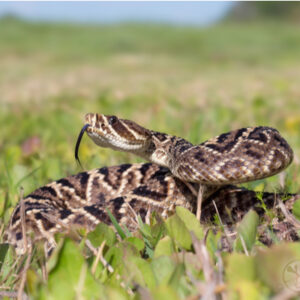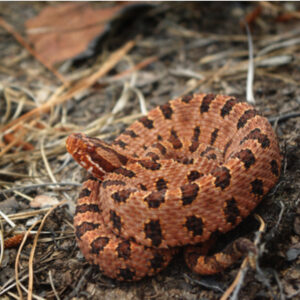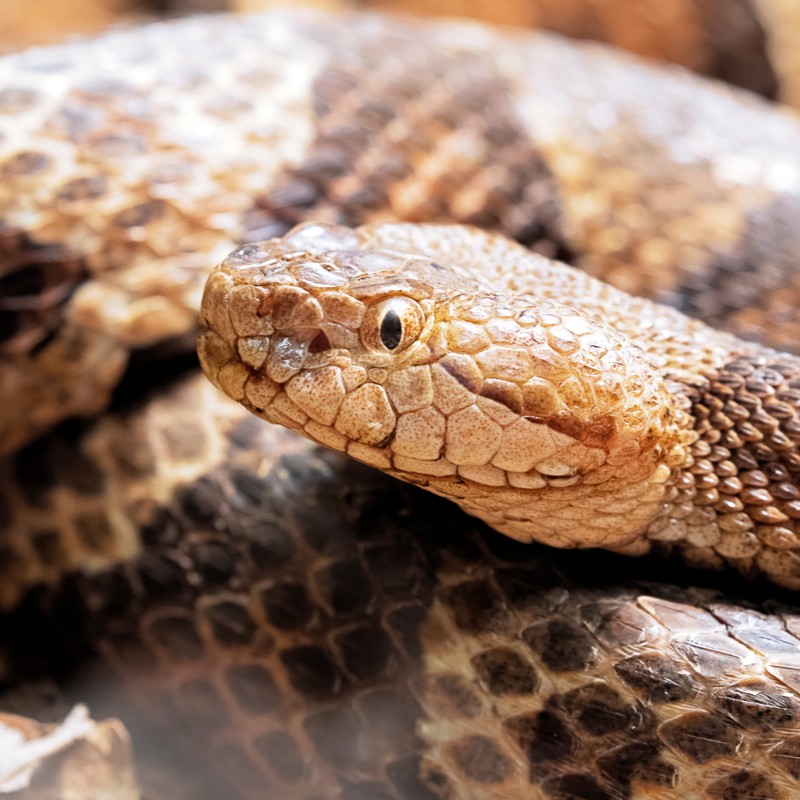Most Venomous Snakes in Georgia
In Georgia, we are blessed with an abundance of wildlife. Unfortunately, some of that wildlife can be very dangerous to humans when threatened. Particularly snakes. There are 46 different species of snakes in the state of Georgia, but only a handful that is considered deadly. Here is a list of the most deadly snakes in Georgia.
Eastern Diamondback Rattlesnake
Maxing out at 8 feet and weighing up to 10 pounds is the eastern diamondback rattlesnake. This rattlesnake is the largest venomous snake in North America. Eastern diamondback rattlesnakes live in woodlands, coastal scrublands, and pine forests. They are recognizable by their black diamond-like markings on their backs. They feed on small rodents like mice, rats, squirrels, and sometimes birds.

Known for their deadly venom, these snakes are just as scared of you as you are of them. The benefit of having the rattle lets them warn you if you get too close. This is not the case with other snakes on this list. Most humans that are bitten by rattlesnakes are either asking for it or trying to capture or kill them. Keep in mind, these snakes can strike up to one-third of their body length.
How Venomous is The Eastern Diamondback Rattlesnake?
Diamondback venom, like the venom of the water moccasin and the coral snake, is a hemotoxin that kills red blood cells and prevents blood from clotting. Bites are extremely painful and are fatal to humans if not treated with antivenom in time.
Water Moccasin
The water moccasin also called the “cottonmouth” is North America’s only venomous water snake. Water moccasins have a recognizable blocky, triangular head, thick body, and a deadly bite. These snakes are semiaquatic, meaning they can travel on land and water. Water moccasins live in the southeastern United States, ranging from Virginia to Florida to eastern Texas. Their habitats include swamps, marshes, ponds, lakes, and streams. They like to sun themselves on rocks and logs near the water’s edge.
How Venomous are Water Moccasins?
Water moccasins’ venom contains hemotoxins that destroy blood cells, preventing the blood from clotting. This can lead to hemorrhaging wherever the venom spreads. The bite of a water moccasin is rarely deadly nowadays with the invention of the antivenom but it can still cause permanent tissue and muscle damage around the area of the bite. If you are bitten by a water moccasin, seek medical attention immediately.
Eastern Coral Snake
Eastern coral snakes are identified by the black, yellow, and red rings that cover its body. They are related to the cobra, mamba, and sea snake. They tend to live in wooded, sandy, and marshy areas of the southeastern United States where they spend most of the time burrowed underground or in leaf piles.
The eastern coral snake can be confused with the scarlet king snake which is also covered in black, yellow, and red rings. They may look almost identical but there is a deadly difference. The scarlet kingsnake is harmless while the eastern coral snake is downright deadly. The way to tell the difference is to remember the old rhyme, “red touch yellow, kill a fellow”. On a coral snake, the red is bordered by yellow rings. On the scarlet kingsnake, the red rings are bordered by black rings Coral snakes only bite humans when they feel threatened.
How Venomous is the Eastern Coral Snake?
When the coral snake bites there is little or no pain at the site. Symptoms can be delayed for up to twelve hours. If not treated by antivenom, then the neurotoxin begins to disrupt the connections between the brain and the muscles, leading to slurred speech, double vision, and muscular paralysis, eventually ending in respiratory or cardiac failure. Luckily, there haven’t been any deaths caused by coral snakes in the US since 1967 when the antivenom was released.

Pigmy Rattlesnake
The pigmy rattlesnake, as its name suggests, is smaller than other species of rattlesnakes. Pygmy rattlesnakes are grey, tan, or lavender and are covered with black spots down their bodies. They can reach up to 31 inches in length but are usually found between 16-23 inches. These snakes live in both wet and dry environments including forests, creeks, swamps, and sandhills. They like to hide in leaf litter and can be hard to spot. Their diet consists of mostly small mammals and birds, lizards, frogs, and insects including giant desert centipedes. They also feed on other snakes.
How Venomous Is the Pigmy Rattlesnake?
While not fatal like it’s longer cousins, the venom of the pigmy rattlesnake can destroy red blood cells, disrupt blood clotting, and can cause excruciating pain.
Copperhead
Copperheads are medium-size snakes that can grow between 2 and 3 feet in length. They have a distinctive pattern of brown to reddish-brown saddlebag-shaped crossbands. Copperheads are responsible for more venomous snakebites than any other in the United States. This is due to the fact, in part because they can tolerate living in urban areas and developed land, making run-ins with humans more common. Copperheads are a type of pit viper, which means they can sense heat. This helps them when they hunt at night.
How Venomous are Copperheads?
Copperhead venom is not as potent as the other snakes on this list; children and the elderly being more susceptible.
Call the Professionals at Progressive Pest Control
If you are having trouble with fall pests or any other type of pest, don’t rely on these venomous snakes to do the job. Call the experts at Progressive Pest Control. We can protect your home from a range of pests from cockroaches to mice.
Our clients can get in touch with us at (706) 654-2730 or contact us here!

